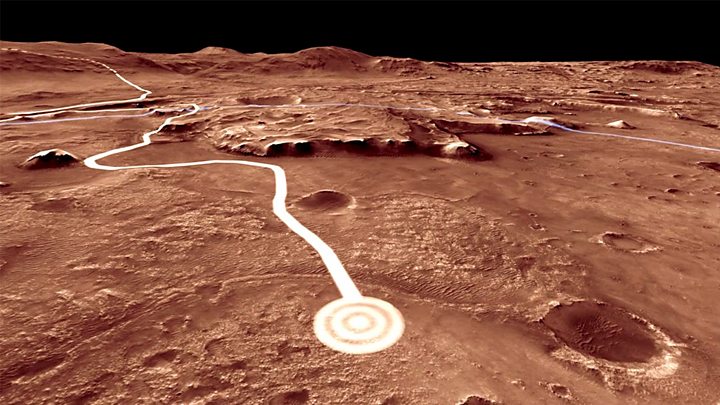
Image copyright
NASA/JPL-CALTECH
Nasa’s Perseverance rover, due to launch to Mars this summer, will search an ancient crater lake for signs of past life. But if biology ever emerged on the Red Planet, how will scientists recognise it? Here, mission scientist Ken Williford explains what they’re looking for.
Today, Mars is hostile to life. It’s too cold for water to stay liquid on the surface, and the thin atmosphere lets through high levels of radiation, potentially sterilising the upper part of the soil.
But it wasn’t always like this. Some 3.5 billion years ago or more, water was flowing on the surface. It carved channels still visible today and pooled in impact craters. A thicker carbon dioxide (CO2) atmosphere would have blocked more of the harmful radiation.
Water is a common ingredient in biology, so it seems plausible that ancient Mars once offered a foothold for life.
In the 1970s, the Viking missions carried an experiment to look for present-day microbes in the Martian soil. But the results were judged inconclusive.
Image copyright
NASA / JPL-Caltech
In the early 2000s, Nasa’s Mars Exploration Rovers were tasked with “following the water”. Opportunity and Spirit found extensive geological evidence for the past presence of liquid water.
The Curiosity rover, which touched down in 2012, found the lake that once filled its landing site at Gale Crater could have supported life. It also detected organic (carbon-containing) molecules that serve as life’s building blocks.
Now, the Perseverance rover will explore a similar environment with instruments designed to test for the signatures of biology.
“I would say it’s the first Nasa mission since Viking to do that,” said Ken Williford, the mission’s deputy project scientist, from Nasa’s Jet Propulsion Laboratory (JPL) in Pasadena, California.
“Viking was the search for extant life – that is, life that might be living on Mars today. Whereas the more recent Nasa approach has been to explore ancient environments because the data we have suggest that the earliest history of the planet tells us that Mars was most habitable during its first billion years.”
The target for Perseverance is Jezero Crater, where signs of a watery past are even clearer, when viewed from orbit, than those at Gale Crater.
The rover will drill into Martian rocks, extracting cores that are about the size of a piece of chalk. These will be sealed away – cached – in containers and left on the surface. These will be collected by another rover, sent at a later date, blasted into Mars orbit and delivered to Earth for analysis. It’s all part of a collaboration with the European Space Agency (Esa) called Mars Sample Return.
Jezero features one of the best-preserved Martian examples of a delta: layered structures formed when rivers enter open bodies of water and deposit rocks, sand and – potentially – organic carbon.
“There’s a river channel flowing in from the west, penetrating the crater rim; and then just inside the crater, at the river mouth, there’s this beautiful delta fan that’s exposed. Our plan is to land right in front of that delta and start exploring,” said Dr Williford.

Media playback is unsupported on your device
The delta contains sand grains originating from rocks further upstream, including a watershed to the north-west.
“The cement between the grains is very interesting – that records the history of the water interacting with that sand at the time of the delta deposition in the lake,” says Ken Williford.
“It provides potential habitats for any organisms living between those grains of sand. Bits of organic matter from any organisms upstream could potentially be washed in.”
Jezero is located in a region that has long been of interest to science. It’s on the western shoulder of a giant impact basin called Isidis, which shows the strongest Martian signals of the minerals olivine and carbonate as measured from space. “Carbonate minerals are one of the key targets that led us to explore this region,” says Ken Williford.
Image copyright
Science Photo Library
A survey of the minerals in Jezero Crater by Dr Briony Horgan of Purdue University, Dr Melissa Rice of Western Washington University (both scientists on the mission) and colleagues, revealed carbonate deposits at the western edge of the ancient shore. These “marginal carbonates” were likened to a bathtub ring – the build-up of soap scum that’s left after the water is drained.
Terrestrial carbonates can lock up biological evidence within their crystals. They can even help form structures that are hardy enough to survive as fossils for billions of years, including seashells, coral and stromatolites.
Stromatolites are formed by many millimetre-scale layers of bacteria and sediment that build up over time into larger structures, sometimes shaped like domes. On Earth, they occur along ancient shorelines, where sunlight and water are plentiful.
Billions of years ago, Jezero’s shore was exactly the kind of place where stromatolites could have formed – and have been preserved – making the carbonate-rich bathtub ring a prime target for the mission.
The rover’s scientific payload will help investigate these questions and others.
Image copyright
Science Photo Library
Two zoom cameras on the rover’s mast – part of the Mastcam-Z system – will survey the landscape, sending back information about the colours, structures and textures.
From several metres away, an instrument called Supercam will fire a laser at rocks to get a measure of their elemental and mineral composition.
This will help scientists select “parking places” where they can deploy the robotic arm. The arm’s drill is used to wear down and flatten a 4.5cm circular patch of rock. The turret – or end – of the arm is then turned around.
An instrument called Sherloc captures images of the flat area and produces a detailed map of the minerals present, including any organics. Another instrument called Pixl will then give scientists the detailed elemental, or chemical, composition of the same area.
Within this data-set, scientists will “look for concentrations of biologically important elements, minerals and molecules – including organic matter. In particular, [it’s] when those things are concentrated in shapes that are potentially suggestive of biology”, says Ken Williford.
Drawing together many lines of evidence is vital; visual identifications alone won’t be enough to convince scientists of a biological origin, given the high bar for claims of extra-terrestrial life. Short of a huge surprise, finds are likely to be described only as potential biosignatures until rocks are sent to Earth for analysis.
Referring to stromatolites, Dr Williford explains: “The layers tend to be irregular and wrinkly, as you might expect for a bunch of microbes living on top of each other. That whole thing can fossilise in a way that’s visible even to the cameras.
“But it’s when we see shapes like that and, maybe, one layer has a different chemistry than the next, but there is some repeating pattern, or we see organic matter concentrated in specific layers – those are the ultimate biosignatures that we might hope to find.”
Yet, Mars might not give up its secrets easily. In 2019, scientists from the mission visited Australia to familiarise themselves with fossil stromatolites that formed 3.48 billion years ago in the country’s Pilbara region.
“We will have to look harder [on Mars] than when we went to the Pilbara… our knowledge of their location comes from many decades of many geologists going year-after-year and mapping the territory,” says Ken Williford.
On Mars, he says, “we are the first ones”.
Image copyright
Briony Horgan
A mineral called hydrated silica also seems to be present near the delta. Its properties also make it good at preserving signs of life, including “microfossils” – the minuscule remains of bacteria, fungi or plants.
On Earth, we can detect fossilised microbes at the level of individual cells. But in order to see them, scientists have to cut out a slice of rock, grind it to within the thickness of a sheet of paper and study it on a glass slide.
No rover can do this. But, then, it might not have to.
“It’s very rare to find an individual microbe hanging out on its own,” says Dr Williford.
“Back when they were alive – if they were anything like Earth microbes – they would have joined together in little communities that build up into structures or clumps of cells that are detectable to the rover.”
After exploring the crater floor, scientists want to drive the rover up onto the rim. Rock cores taken here, when analysed on Earth, could provide an age for the impact that carved out the crater and a maximum age for the lake.
But there’s another reason for being interested in the crater rim. When a large space object slams into rocks containing water, the huge energy can set up hydrothermal systems – where hot water circulates through the rocks. The hot water dissolves minerals from the rocks that provide the necessary ingredients for life.
Image copyright
NASA/JPL/JHUAPL/MSSS/BROWN UNIVERSITY
“If that happened, that would have been the first habitable environment at Jezero Crater,” says Ken Williford. The evidence – along with signs of any life that colonised the environment – could be preserved up on the rim.
The current mission scenario foresees the rover driving to the nearby north-east Syrtis region as an “aspirational goal”.
It’s more ancient even than Jezero and also holds the promise of exposed carbonates – which may have formed in a different way to those in the crater.
If, by the end of this mission, signs of past life haven’t presented themselves, the search won’t be over. The focus will turn to those cores, waiting for delivery to Earth.
But the exciting prospect remains that the mission might not just throw up more questions, but answers too. That outcome could be planet-shaking. Whatever lies in wait for plucky Perseverance, we are on the verge of a new phase in our understanding of Earth’s near-neighbour.
Follow Paul on Twitter.
Read MoreFeedzy


